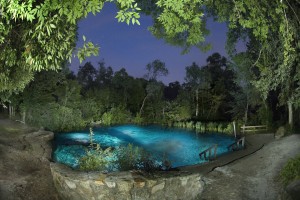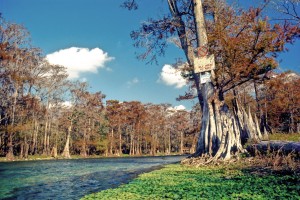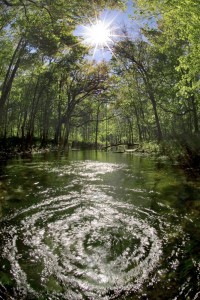
Photo by Jill Heinerth
As required by Florida law “in order to prevent significant harm as a result of withdrawals,” the Suwannee River Water Management District (SRWMD) is currently working to set minimum flows and levels (MFLs) for the Ichetucknee River and its associated priority springs as well as for the lower Santa Fe River.
The district’s deadline to receive public comments about these MFLs is Oct. 8, 2013. There is also an opportunity to offer public comment in a workshop beginning at 1 p.m. Wed., Sept. 18, in room 122 Frazier Rogers Hall at the University of Florida. Call Carlos Herd at 386-362-1001 for details.
The district has concluded that if water flow rates and water heights fall below the district-defined MFLs, significant harm may eventually occur in the river, springs and related ecosystems; the life forms that those ecosystems support may also be harmed. The district-defined MFL, however, is a long-term statistical representation of the flow of water in the river, not a set flow that would be violated if the river falls below it. In other words, the river’s flow can be lower than the MFL for a period of time and still not be considered to be in violation of the MFL.
Representatives of the Suwannee River Water Management District have indicated in recent public meetings that after they have set the MFLs, the lower Santa Fe River will be considered to be “in recovery”—meaning a plan must be developed by the district to help the river recover reduced flow—while the Ichetucknee River will be considered to be “in prevention,” meaning that its MFL will probably be violated sometime within the next 20 years.

Photo by Jim Stevenson
The Ichetucknee Alliance is concerned not only with protection and preservation of the Ichetucknee River System but also with restoration of that system. Flows already fluctuate between 18% and 25% less than the historic average discharge. In addition, gradual changes in chemistry of the water because of changing ratios of groundwater (from the springs) to surface water can slowly alter the biota of the entire system. The Alliance’s position is that since the reduced flow of the river and its associated springs is already causing changes and significant harm, the flow should not be reduced further.
In a letter dated June 24, 2013, from the Alliance’s President John Jopling to SRWMD Executive Director Ann Shortelle, the Alliance has recommended a minimum average flow rate for the Ichetucknee River of no less than 350 cubic feet per second (cfs), the river’s historical average flow as identified in the restoration plan prepared by scientists at the Howard T. Odum Florida Springs Institute.
If the restoration, preservation and protection of the Ichetucknee River and its associated springs are important to you, we urge you to visit the links provided below to learn more about the MFL process, make your own decisions and, if you wish, submit your comments to the Suwannee River Water Management District by October 8, 2013.
The district offers two preferred ways to comment: (1) via the online comment form at: http://www.mysuwanneeriver.com/FormCenter/Water-Supply-5/Minimum-Flows–Levels-Comment-Form-40; and (2) via email to: <MFLs@srwmd.org>.
A few things to keep in mind:

Photo by John Jopling
Manatee habitat. The biologist at Ichetucknee Springs State Park has a spreadsheet of approximately 225 manatee observations in the Ichetucknee that were recorded during the past 10 years. According to retired Florida Department of Environmental Protection Biologist Jim Stevenson, who chaired the Ichetucknee Springs Basin Working Group for 15 years from 1995-2010:
“There would be significantly more observations if the manatees could enter the river year round…when the Santa Fe is at a low level, manatees cannot enter the Ichetucknee because of the lime rock sill that blocks access…This means that manatee habitat is not accessible to this endangered species during such low levels in the Santa Fe or low levels in the Ichetucknee that may be caused by reduced spring flow.
An MFL that allows the discharge of the Lower Santa Fe River and the Ichetucknee River to be lowered further would necessarily result in the loss of warm water refugia habitat because access would be restricted on more days than at present. The SRWMD has stated unequivocally that endangered species protection was paramount and that determining some acceptable loss of endangered species habitat was inappropriate.”

Ecosystem damage and fewer recreational opportunities. Stevenson also has concerns about how low flows in the Ichetucknee River could lead to further ecosystem damage and fewer opportunities for recreational use:
“…tuber damage is…caused by wading/trampling in shallow reaches of the river. The lower the water level the more river bottom is trampled, causing damage to the submerged aquatic vegetation. Furthermore, turbidity and sedimentation are caused by tuber wading that impacts the aesthetic value of water clarity throughout the length of the river during tubing days. It is disturbing to watch the clear blue water turn cloudy as tubers advance downstream…The Florida Springs Institute’s Ichetucknee Springs Report Card of 2008 identifies clarity as an issue.
Carrying capacities have been set and adjusted on the Ichetucknee since the early 1980s to balance recreational use with preservation of the natural values. If the river level is decreased to a lower level, the Florida Park Service will have to adjust the capacity, thereby limiting use so as to protect the ecology of the river. Such a scenario will impact natural, recreational and economic values of the Ichetucknee Springs and River and would constitute a ‘significant harm’ under any reasonable interpretation.”

Photo by John Moran
Aesthetics of spring boils. Finally, Stevenson makes an important point about the qualitative, aesthetic value of a spring boil—the very visible evidence of a healthy spring that was described by early explorers of Florida:
“Spring boils have become rare. In 1774, William Bartram wrote that (Volusia) Blue Spring ‘boiled up with great force.’ Today it is hardly a ripple. Where can a Floridian see a spring boil today? The best, and perhaps one of the last, is Ichetucknee’s Mill Pond Spring boil. When the proposed MFL is reached, will this aesthetic gem remain or, like so much of natural Florida, will it only be found in a photograph?…The loss of any of the prominent boils constitutes significant harm even though it cannot be quantified. Yellowstone’s Old Faithful is an appropriate analogy; the loss of any of its height would be significantly harmful whether any hot pool critter suffered or not.”
Selected Sources of Additional Information (Note: Some older links have broken.)
(1) The relevant Florida Statute for MFLs is 373.042:
http://www.flsenate.gov/laws/statutes/2011/373.042
(2) More information about MFLs is available on the Florida Department of Environmental Protection’s Office of Water Policy website at: http://www.dep.state.fl.us/water/waterpolicy/mfl.htm
and in the Suwannee River Water Management District’s Minimum Flows and Levels Fact Sheet at:
http://www.srwmd.state.fl.us/DocumentCenter/View/86
(3) The Suwannee River Water Management District has made many MFL-related documents available for download (be patient, some are slow to load) at:
http://fl-suwanneeriver.civicplus.com/index.aspx?NID=121
(4) The above information from Jim Stevenson was excerpted with his permission from his letter of July 3, 2013, to an employee of the Suwannee River Water Management District (with light edits to that letter by Bob Knight).
